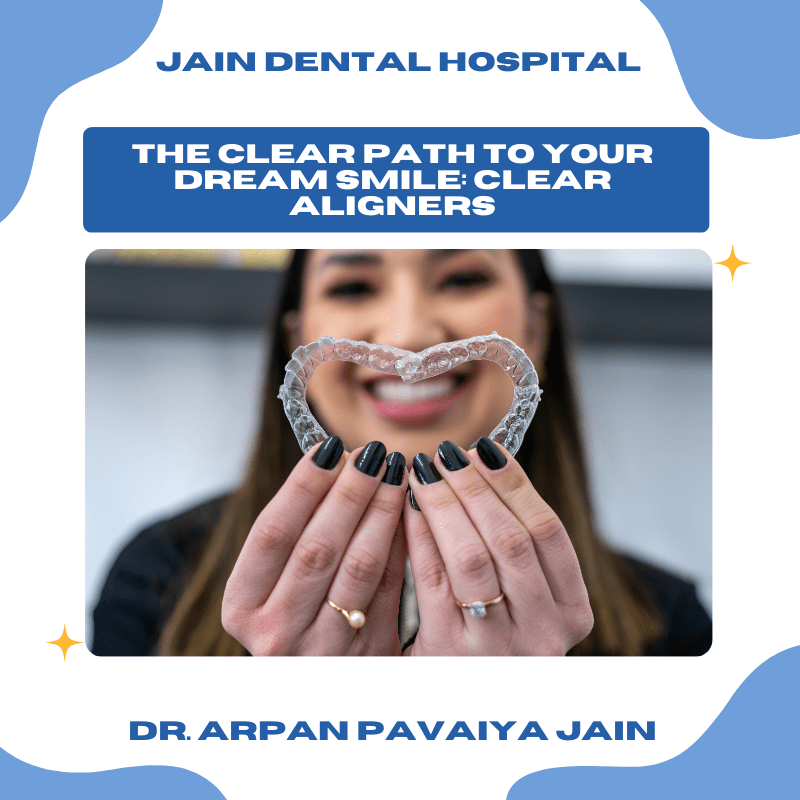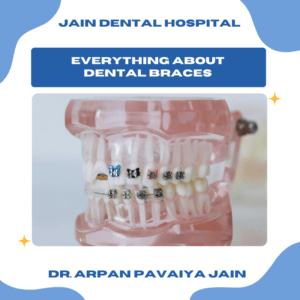A Step-by-Step Guide to Your Clear Aligner Journey
The Clear Path to Your Dream Smile: Clear Aligners
In today’s world, achieving a perfect smile has never been easier, thanks to the revolutionary technology behind clear aligners. Whether you’re a teenager, a working professional, or even a bride-to-be, clear aligners offer a discreet and comfortable way to straighten your teeth without the need for traditional metal braces.
This comprehensive guide will walk you through the step-by-step process that is designed to help you understand the entire clear aligner treatment process, from your initial consultation to finally maintaining your new smile. By the end of this guide, you’ll be well-prepared to confidently start your clear aligner journey.
Introduction
Clear aligners have revolutionized how we straighten teeth, offering a discreet and comfortable alternative to traditional braces. These custom-made, transparent trays fit snugly over your teeth, gradually moving them into the desired position.
Their benefits over traditional braces are numerous. They’re nearly invisible, making them a popular choice for image-conscious individuals. They’re also removable, so you can eat, brush, and floss without any hassle.
So, understanding the treatment process is crucial for achieving the best results, so let’s walk through each step together.
Clear Aligners Treatment Process
Step 1: Consultation with an Orthodontist
The initial consultation is a critical first step in your clear aligner journey, setting the foundation for your treatment plan.
During the consultation, you will meet with either an orthodontist or a dental professional who is specifically trained in clear aligner therapy. This initial appointment is crucial for determining your eligibility for clear aligners and discussing your treatment goals.
During the consultation, the orthodontist will conduct a thorough examination of your teeth, jaws, and bite. This may involve taking X-rays and 3D Scans to get impressions of your teeth to create a precise 3D digital model of your mouth.
This technological examination allows the orthodontist to assess your specific needs. The orthodontist will also discuss your dental history, including any previous orthodontic treatment or jaw surgery.
Based on the examination, the orthodontist will explain the process of clear aligner treatment, the number of aligners you may need including the expected timeline, and any potential challenges that could arise during treatment.
Pricing and payment options will be discussed to ensure that you have a comprehensive understanding of the financial implications prior to proceeding.
The orthodontist will also assess your suitability for clear aligners and discuss your treatment goals. They will consider factors such as the severity of your misalignment, the health of your teeth and gums, and your overall oral health.
Here are some key things that your orthodontist will discuss during the consultation:
- Your dental history: Your orthodontist will enquire about any previous dental treatments; such as braces or fillings.
- Your treatment goals: He will also discuss what you hope to achieve with clear aligners, such as straightening your teeth, closing gaps between teeth, or correcting your bite.
All this will help the orthodontist develop a personalized treatment plan that meets your specific needs.
The consultation is not only a time to gather information but also an opportunity for you to ask any questions that may arise. Please feel free to discuss any concerns about potential side effects or risks.
This initial consultation is a chance to establish a positive rapport with your dental team.
A qualified orthodontist will be able to provide you with the information you need to make an informed decision about whether clear aligners are the right choice for you.
By the end of this consultation, you will have gained a deeper understanding of clear aligners and determined if they are the optimal choice for your orthodontic needs.
By openly discussing your expectations and concerns with your orthodontist, you can make an informed decision about your treatment and embark on your path toward a straighter smile.
Step 2: Digital Impressions and Scans
Creating a Digital Model of Your Teeth
Once you have completed your initial consultation and agreed on a treatment plan. The next crucial step in your clear aligner journey involves creating a digital model of your teeth.
This step is essential for creating a precise and personalized set of clear aligners those are tailored specifically to your dental structure.
This model will serve as a blueprint for your treatment plan. To create the model, your orthodontist will take impressions and scans of your teeth either using a putty-like material or a small handheld 3D intraoral digital scanner.
The method your orthodontist will use depends on their preference and the specific technology they have available.
Nowadays, Digital scanners are becoming increasingly popular due to their speed, accuracy, and comfort for patients. However, traditional putty impressions are still a reliable option.
The accuracy of digital impressions is a major advantage over conventional molds, Leading to a more comfortable experience with fewer errors. This precision ensures that your aligners fit snugly and comfortably, which is crucial for effective treatment.
If your dentist decides to use a 3D intraoral digital scanner then during this process, state-of-the-art technology is used to capture the exact shape and alignment of your teeth and gums.
Digital impressions are taken using a small handheld scanner that captures thousands of images of your mouth in just a few minutes. The scanner emits light onto the teeth and uses sensors to capture the reflections, creating a 3D map of the oral cavity.
These scanned images are combined using specialized software to generate a highly detailed 3D model of our teeth.
As this 3D model is immediately available on a computer screen and accurately represents the size, shape, and position of each tooth.
It allows your orthodontist to visualize the patient’s current oral condition and plan various phases of treatment accordingly.
Step 3: Treatment Planning
Once your digital impressions and scans have been completed, Utilizing the advanced 3D model, your orthodontist will proceed to the treatment planning phase, an integral part of your clear aligner journey.
The orthodontist will develop a comprehensive treatment plan that accurately previews the gradual shifting of your teeth during the alignment process while considering factors such as your bite, jaw alignment, and any existing dental issues.
The treatment plan will also take into account any specific concerns or goals you may have, such as closing gaps between teeth, correcting overbites or underbites, or improving your smile’s overall appearance.
Your orthodontist will discuss the plan with you in detail, addressing any questions you may have.
Additionally, he will discuss with you the anticipated duration of treatment. The timeline may fluctuate depending on the intricacies of your dental condition.
Although the standard treatment period is generally between six months and two years, your individualized plan will be designed to align with your specific requirements.
Treatment planning extends beyond outlining the steps involved; it also addresses the rationale behind each phase.
Your orthodontist will provide you a clear explanation for the sequence and purpose of treatment, ensuring your understanding of the timeline and anticipated dental movements.
This transparency fosters your informed participation throughout the process, empowering you to be an active partner in achieving your desired smile transformation.
Using precise algorithms, the software will generate a series of aligners, each representing a stage in your treatment process.
Now you’ll have a visual representation of the entire progression of your teeth, illustrating how they will move with each new aligner.
This preview can be both motivating and reassuring, as you can see the end goal of your orthodontic journey—a beautiful, aligned smile.
In addition, this method can often obviate the necessity for follow-up adjustment appointments, as the entire procedure can be conducted expeditiously, thereby reducing the number of office visits required.
With all aspects of your treatment plan in place, you’re one step closer to the fabrication of your custom aligners, setting the stage for a successful and rewarding treatment journey toward achieving your dream smile.
Step 4: Aligner Fabrication
Following the completion of your personalized treatment plan, your digital scan and impressions are sent to the specialized laboratory for the fabrication of your custom clear aligners.
It is a complex process that involves precision engineering and advanced materials. This process utilizes advanced materials, typically a high-quality thermoplastic known for its durability and flexibility.
The clear aligners are crafted using state-of-the-art 3D printing technology, which allows for precise reproduction of the digital model created during your scans.
Each aligner is formed to snugly fit your teeth as dictated by the treatment plan, ensuring optimal effectiveness throughout your orthodontic journey.
Quality assurance is a fundamental aspect of the fabrication process. Each batch of aligners is subjected to comprehensive testing to confirm its compliance with stringent dental standards, including dimensional accuracy, thickness, and conformity to the prescribed treatment plan.
Orthodontic professionals often conduct evaluations throughout the production stages, utilizing advanced imaging systems to ensure every aligner fits perfectly and achieves the intended tooth movements.
Typically, the turnaround time for aligner delivery ranges from one to three weeks, depending on the complexity of your case and the specific processes used by the orthodontic lab.
This timeframe allows for the meticulous crafting and quality checks that guarantee every aligner is ready to seamlessly assist in your smile transformation.
Upon completion of your aligners, your orthodontist will schedule a fitting appointment. During this visit, you will receive your initial series of aligners, along with detailed instructions regarding their proper wear and care.
In the next section, we’ll delve into how to properly wear and maintain your aligners, as well as what to expect in the next phase of your treatment journey.
Step 5: Aligner Delivery and Instructions
As you embark on your journey with clear aligners, understanding the delivery process and instructions is crucial for ensuring the effectiveness of your treatment.
Receiving Your First Set of Aligners
Once your custom aligners are fabricated, you will receive your first set during a scheduled fitting appointment with your orthodontist. During this appointment, your orthodontist will ensure that each aligner fits correctly and comfortably.
You will be provided with a guide that outlines your specific treatment plan, including the duration you should wear each aligner before transitioning to the next set.
Proper Insertion and Removal Techniques
It’s vital to become adept at inserting and removing your aligners properly to avoid damage or improper fit. To insert the aligners, gently place them over your teeth, starting from the back and working towards the front until they snap into place.
When removing them, use a gentle prying motion with your fingertips or a dedicated aligner removal tool to avoid exerting excessive force that could warp the aligners.
Caring for Your Aligners and Maintaining Oral Hygiene
Maintaining good oral hygiene is essential while undergoing treatment with clear aligners. Always brush and floss your teeth before reinserting your aligners to minimize the risk of plaque buildup.
You should clean your aligners using a soft toothbrush and lukewarm water daily. Avoid using hot water, as it can warp the plastic material.
Additionally, consider using an aligner cleaning solution or special cleaning crystals to maintain their clarity and hygiene.
Removing Aligners for Eating and Brushing
It is important to remove your aligners when eating or drinking anything other than water. This prevents staining and damage to the aligners, allowing them to exert the necessary pressure on your teeth effectively.
After meals, be sure to brush your teeth and rinse your aligners before reinserting them, ensuring a clean, healthy environment for your teeth and aligners.
Cleaning and Storing Aligners
When you’re not wearing your aligners, store them in their designated case to protect them from damage and contamination. Avoid leaving them out in the open, as they can easily become lost or inadvertently damaged.
Regular cleaning, paired with proper storage, helps maintain the integrity of the aligners and supports your goal of achieving a healthy, beautiful smile.
By adhering to these essential guidelines for aligner delivery and usage, you can optimize your treatment experience and work towards your desired outcome confidently.
Step 6: Wearing Your Aligners
Wearing your clear aligners consistently is paramount to the success of your orthodontic treatment. It is recommended that you wear your aligners for at least 22 hours a day, removing them only for eating, drinking (except for water), brushing, and flossing.
This level of commitment ensures that the aligners can apply the necessary pressure on your teeth throughout the day, facilitating the intended movements as part of your treatment plan.
Skipping hours or days can prolong the treatment process, lead to unwanted shifts in your teeth, and affect the overall outcomes.
Tracking your progress is equally vital. Regularly reviewing your treatment plan with your orthodontist can help you stay on course and make any necessary adjustments to your wear schedule.
This tracking not only empowers you to take charge of your orthodontic journey but also serves as a reminder of the commitment you’re making toward achieving a perfect smile.
Discomfort or adjustments can be expected as your teeth shift into their new positions. This is completely normal and typically subsides within a few days after switching to a new set of aligners.
To alleviate any discomfort, consider taking over-the-counter pain relief medication or using a warm saltwater rinse. If ongoing pain or issues arise, reach out to your orthodontist for advice.
Remember that each adjustment is a step closer to your goal, and maintaining open communication with your orthodontist will help ensure a smoother transition throughout your treatment journey.
Step 7: Follow-Up Appointments
Follow-up appointments with your orthodontist are a crucial aspect of your orthodontic journey, serving multiple purposes that directly contribute to the effectiveness of your treatment.
Regular check-ups provide an opportunity for your orthodontist to monitor your progress, ensuring that your teeth are moving as planned and that the aligners are working effectively.
These appointments are typically scheduled every 4 to 6 weeks, allowing for timely evaluations and adjustments.
One of the primary goals of these visits is to assess your progress. Your orthodontist will examine your teeth, check for any shifts, and determine if the aligners are fitting correctly.
If any issues are detected, such as a lack of movement or discomfort that suggests improper fit, your orthodontist can make necessary adjustments.
This might include refining your treatment plan, changing your aligners earlier than scheduled, or even modifying your wear schedule to enhance effectiveness.
Regular monitoring helps to ensure that you remain on track toward achieving your desired outcome.
Another important aspect of follow-up appointments is reinforcing the significance of compliance. Your orthodontist will discuss your commitment to wearing the aligners for the recommended duration each day.
Open communication is vital during these visits; sharing your experiences, any discomfort, and your adherence to the treatment plan allows your orthodontist to tailor their advice to better suit your needs.
If you’ve encountered challenges in wearing the aligners consistently, these discussions can lead to strategies that help you maintain your commitment while also addressing any concerns you may have.
Moreover, these appointments are an opportunity for you to ask questions and clarify any doubts about your treatment. Understanding the process and what to expect can alleviate anxiety and foster a positive outlook on your journey to a perfect smile.
Remember, your orthodontist is there to support you, and fostering a cooperative relationship can make your experience smoother and more enjoyable.
Step 8: Challenges and Solutions
While clear aligners are an effective method for achieving a straighter smile, many users experience challenges throughout their treatment journey.
Understanding these obstacles and employing practical solutions can help ensure a smoother experience.
Common Discomfort and How to Manage It
It’s normal to experience some discomfort when starting with a new set of aligners, as they apply pressure to gradually shift your teeth. This discomfort usually occurs in the first few days of wearing a new aligner.
To manage this, consider taking over-the-counter pain relief medication, if recommended by your healthcare provider.
Additionally, you can alleviate discomfort by using orthodontic wax on any areas of your gums that may be irritated by the aligners. Ice packs or cold compresses can also provide relief if you experience swelling or soreness.
Dealing with Aligner-Related Issues
Food getting stuck in aligners can be an annoying aspect of the treatment process, but it’s manageable. To prevent this, always remember to remove your aligners before meals, ensuring they remain clean and free from residue.
If you accidentally do have food stuck in your aligners, rinse them out with water as soon as possible to minimize staining and maintain oral hygiene.
Regularly cleaning your aligners with a soft toothbrush and lukewarm water is essential to avoid build-up and ensure they remain clear and effective.
Tips for Staying Compliant with Your Treatment
Staying compliant with your treatment plan is vital for achieving your desired results within the prescribed timeframe.
One effective strategy is to set reminders on your phone or use a calendar to track your wear schedule, ensuring you wear your aligners for the recommended 20-22 hours each day.
Creating a daily routine can also help; try to align your aligner removal and reinsertion with specific activities—such as brushing your teeth after meals—making it easier to adhere to the regimen.
Lastly, consider enlisting a support system, such as family or friends, who can help keep you accountable throughout the process.
By recognizing and addressing these common challenges, you can significantly enhance your experience with clear aligners, ensuring a successful journey toward that perfect smile.
Step 9: Retention and Maintaining Your Results
Once your treatment with clear aligners is complete and you have achieved your desired smile, the journey isn’t quite over—it is crucial to focus on retention to maintain those results.
Wearing retainers after treatment is a vital step that helps ensure your teeth remain in their new positions. Retainers work by keeping the teeth in place as the surrounding bone and gums adapt to their new alignment.
Your orthodontist will determine the appropriate type of retainer for your needs and guide you on how often to wear it, typically recommending full-time wear initially, followed by a gradual reduction to night-time use.
Lifelong retention is essential to prevent relapse, as teeth have a natural tendency to shift back toward their original positions over time.
This means that even after years of wear, a consistent retainer routine can safeguard your investment in your smile.
Neglecting to wear retainers as advised increases the risk of relapse, which can lead to misalignment and the need for additional orthodontic treatment down the road.
To maintain your retainers and promote good oral hygiene, follow these tips: Always clean your retainers with a soft brush using lukewarm water—avoid hot water that can warp the plastic.
Additionally, be sure to store them in a protective case when not in use to prevent damage. Regularly rinse your retainers with a gentle solution recommended by your orthodontist to protect against bacteria buildup and odors.
Finally, maintain a thorough oral hygiene routine by brushing and flossing your teeth daily, ensuring that both your teeth and retainers remain in optimal condition.
By adhering to these practices, you will be well on your way to enjoying your beautiful smile for years to come.
Conclusion
In summary, the clear aligner treatment process offers a comprehensive and effective path to achieving your dream smile.
By following this step-by-step guide, from your initial consultation and customized treatment plan to regular follow-up appointments and the crucial retention phase, each step plays an integral role in your journey.
Remember, patience and commitment are key; while the transformation may take time, the results will be well worth the effort. As you take this journey, don’t hesitate to seek support from your orthodontist and loved ones to stay motivated.
Now is the perfect time to take the first step—embrace the opportunity to invest in your smile and unlock your confidence.
Start your clear aligner journey today and get ready to reveal the beautiful smile you’ve always desired!
Start Your Clear Aligner Journey Today!
Ready to begin your journey to a straighter smile with clear aligners? Jain Dental Hospital is here to guide you every step of the way.
Schedule a consultation today to discuss your smile goals and learn more about what to expect during your personalized clear aligner treatment.
Call us at +91-9582535204 or visit our website at www.jaindentistdelhi.com to book your appointment online. We look forward to seeing you smile!

Dr. Arpan Pavaiya Jain, Director of Jain Dental Hospital, Indirapuram, Ghaziabad, and Noida is a renowned Prosthodontist and Implantologist with over 20 years of expertise in advanced dentistry. A graduate of the prestigious King George’s Medical College Lucknow, he has performed more than 20,000 successful dental implant procedures. Dr. Jain leads a team of skilled professionals, offering state-of-the-art treatments in dental implants, clear aligners, cosmetic dentistry, orthodontics, and more. Known for his personalized care and commitment to excellence, he has earned a reputation as a trusted dental expert in Indirapuram, Ghaziabad, and Noida.





